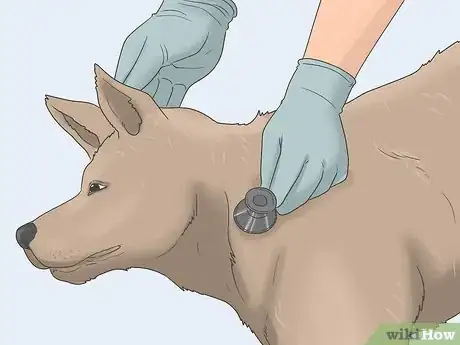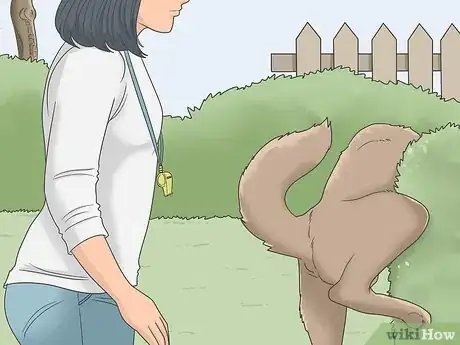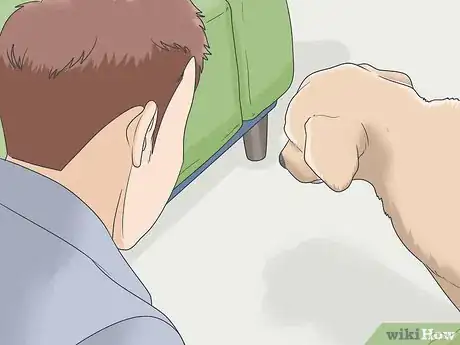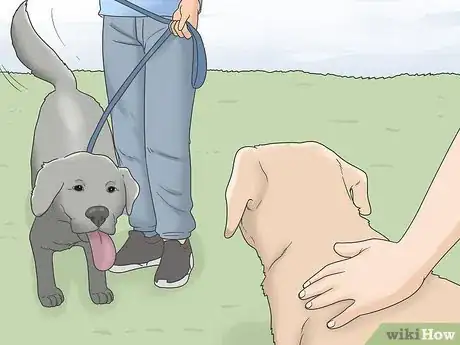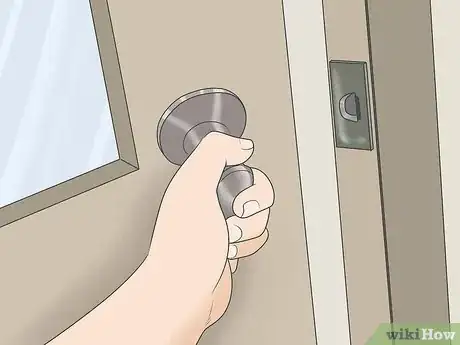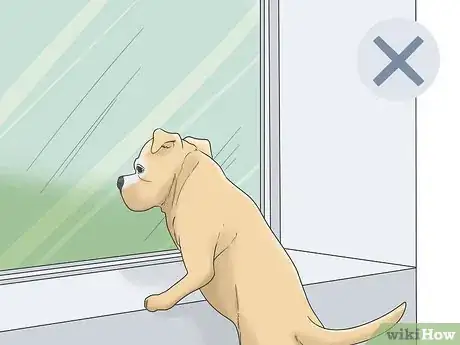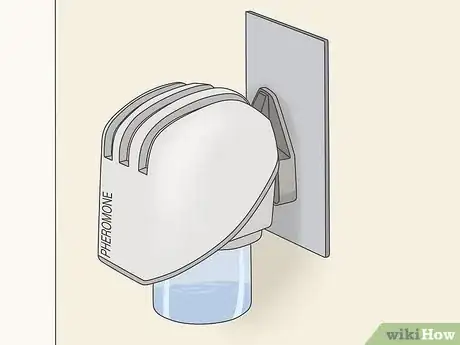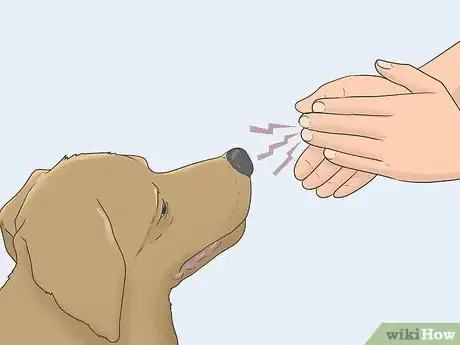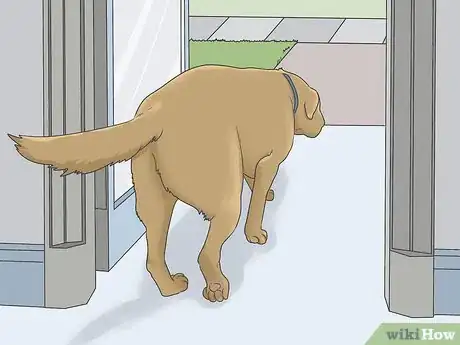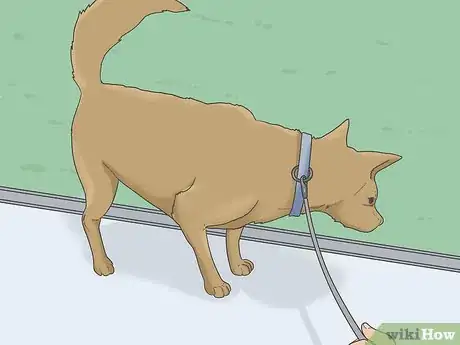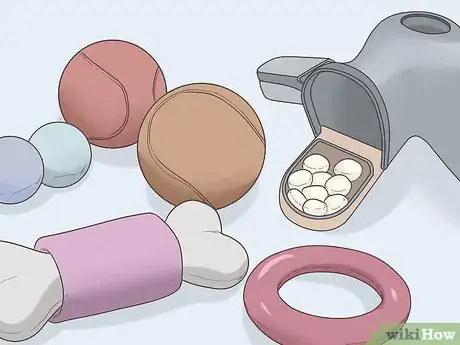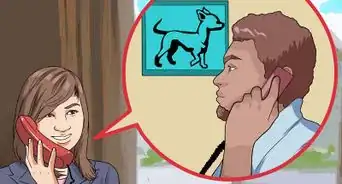This article was co-authored by Indigo Will and by wikiHow staff writer, Megaera Lorenz, PhD. Indigo Will is a Canine Expert, Trainer, and Founder and Owner of K9-INDIGO® Holistic Dog Training LLC™, a dog training service in Los Angeles, California. Indigo specializes in understanding canine temperament and dispositions to allow canines to reach their full potential. He has studied various methods of training and philosophies to develop a unique, innovative, and result-driven method for canine behavior training.
There are 10 references cited in this article, which can be found at the bottom of the page.
wikiHow marks an article as reader-approved once it receives enough positive feedback. In this case, 100% of readers who voted found the article helpful, earning it our reader-approved status.
This article has been viewed 357,474 times.
While urine marking can be frustrating and upsetting for dog owners, it’s a completely normal behavior for dogs.[1] Your dog may mark if it’s anxious, excited, or curious about a new object or environment, and especially if it smells urine left by other dogs.[2] One of the best ways to cut down on unwanted marking is to spay or neuter your dog. You can also reduce this behavior by minimizing sources of stress for your dog and training it to behave appropriately in exciting or stressful situations.
Steps
Getting Veterinary Help
-
1See your vet to rule out underlying medical causes. If your dog is urinating around the house, it may simply be marking. However, inappropriate urination can sometimes be a sign of a more serious problem, like a urinary tract infection. If you’re not sure what’s causing your dog’s behavior, schedule a visit with your vet.[3]
- Let your vet know when the behavior started and tell them if you’ve noticed your dog acting sick or displaying any other unusual behaviors or symptoms.
- Tell your vet about any recent changes in your dog’s home environment or routine, such as a move or the addition of a new pet.
-
2Have your dog spayed or neutered. Sexually mature dogs that aren’t spayed or neutered are much more likely to mark than dogs that are fixed.[4] If you haven’t already done so, schedule an appointment with your vet to get your dog fixed as soon as possible.
- The earlier you neuter or spay your dog, the more likely it is that you can prevent or eliminate marking behaviors entirely.[6]
- If your dog already has a habit of marking, neutering may help, but you’ll probably need to combine it with training.
Tip: If you’re worried about the cost of spaying or neutering your dog, do a search online for low-cost spay/neuter programs in your area. You may also be able to get information about affordable spay/neuter options from a local vet or animal shelter.[5]
Advertisement -
3Ask your vet about medications to treat anxiety. Anxiety is a common cause of marking behaviors in dogs. While the best solution is usually to deal with the cause of the anxiety, medications can also help. Talk to your vet about giving your dog an anxiety medication to help it stay calm while you work on modifying the marking behavior.[7]
- Your vet may prescribe an antidepressant medication, such as a tricyclic antidepressant or an SSRI (selective serotonin reuptake inhibitor), to help calm your dog and reduce marking behaviors.[8]
-
4Get a referral to a behavioral specialist if you need extra help. If other treatment approaches aren’t working or you just aren’t sure where to start, ask your vet to recommend an animal behaviorist.[9] They can help you get to the root of the marking problem and suggest strategies for changing your dog’s behavior.
- Before taking your dog straight to a behaviorist, it’s a good idea to see a vet first. Not only can they recommend a reputable behaviorist, but they can help rule out possible physical problems that a behaviorist won’t be able to diagnose or treat.[10]
- A behaviorist can also help you determine whether your dog is truly marking or if you’re seeing another type of behavior problem, such as submissive urination or poor housetraining.
Dealing with Environmental Causes
-
1Identify possible sources of stress for your dog. Dogs often mark when they feel anxious, stressed, or threatened. Think about whether anything may have changed in your dog’s environment or daily routine that could be causing stress or anxiety. Once you identify what’s causing the dog to mark, you can either eliminate the source of stress or work on modifying your dog’s behavior around it.[11] Possible causes could include:
- A new pet or human in the home
- New furniture or other unfamiliar objects in your dog’s environment
- Unfamiliar noises or smells in your home
- A recent move
- A change in your routine, such as a new work schedule
-
2Supervise your dog around new objects or environments. If you bring a new object into your home, such as a piece of furniture or a houseplant, watch your dog closely around it. Allow your dog to sniff and explore the new item, but quickly remove your dog from the area if you notice leg-lifting or other signals that it is about to mark. Likewise, keep a close eye on your dog when it’s exploring new places (such as a new home or a friend’s apartment).[12]
- You may find it helpful to keep your dog on a leash when it’s exploring new surroundings. That will make it easier to quickly get control of your dog if you see signs that it’s about to mark.
-
3Introduce your dog to new animals and people gradually. If you’re bringing a new pet, roommate, or family member into your home, it’s important to make the introduction as positive and stress-free as possible for your dog. Always supervise interactions between your dog and the new person or animal until the dog is used to their presence, and keep encounters brief at first.
- When your dog is around the new resident, keep the experience positive by playing with your dog, petting it, and offering treats and praise for appropriate behaviors (like staying calm and obeying commands).[14]
Warning: If your dog tends to mark, it will be encouraged to do so more if it smells urine or sexual odors from other dogs. Keep your dog away from females in heat or areas where other animals have marked.[13]
-
4Clean previously marked areas thoroughly. If your dog or another pet has already marked any areas in the house, clean the area to eliminate any traces of the odor. Otherwise, your dog may smell it and continue to mark in that area.[15] Use an enzymatic cleaner designed specifically to break down and eliminate pet urine stains and odors.[16]
- Avoid using steam cleaners or cleaning products with strong odors, such as ammonia or vinegar. Steam cleaning can cause urine odors to become set into the marked material, and strong chemical odors may encourage your dog to mark even more.[17]
- You can buy enzymatic cleansers online, in pet supply stores, or in the cleaning section of many home supply or grocery stores.
-
5Keep your dog away from objects and areas it wants to mark. If your dog is determined to mark a particular object or area, restricting its access may be your best bet. Try using a gate or door to block off rooms where your dog likes to mark. If you think your dog is likely to mark unfamiliar objects, like a visitor’s shoes or purse, put them in a closet or a closed room where your dog can’t get at them.[18]
- If you can’t block your dog’s access to an area where it likes to mark, try changing your dog’s associations with that area. For example, you might try distracting your dog by playing with it or offering treats next to previously marked areas.
-
6Restrict your dog’s view through windows and doors. Your dog may mark if it sees other dogs, cats, or wild animals outside. To keep this from happening, try blocking your dog’s view of the outdoors with curtains, blinds, or shades. Alternatively, keep your dog away from windows and doors that it might be able to look through when you’re not around to supervise.[19]
- If you can’t keep your dog from looking out your doors and windows, look for ways to discourage other animals from coming near your home. For example, get rid of food sources (such as birdseed or unsecured garbage cans) or use sound or odor-based deterrents.
-
7Confine your dog to a crate when you’re not around. If your dog tends to mark when you’re not home to supervise it, keep it confined in a crate or a designated area whenever you leave. This will prevent the dog from learning that it’s okay to mark all over the house when you’re away.[20]
- If your dog isn’t crate trained, try keeping it in a small, easily cleaned room in your home, such as a laundry room, bathroom, or kitchen. Make sure the dog always has access to food and clean water, and provide toys to keep it busy.
-
8Try a pheromone diffuser to create a calming environment. Pheromone diffusers, such as ADAPTIL, work by mimicking the natural scent that mother dogs produce to soothe their puppies.[21] Plug in a pheromone diffuser in an area where you think your dog might mark to help create a soothing, familiar-smelling atmosphere.[22]
- You can purchase pheromone diffusers online, from a pet supply store, or from your vet’s office.
- Soothing dog pheromones are also available as sprays or in calming collars.
Discouraging Marking Behavior with Training
-
1Distract your dog with a loud noise if you think it’s about to mark. If you see your dog start to urinate in an inappropriate place, make a loud noise to interrupt your dog. For example, you might clap your hands loudly and say “No!” or “Hey!” in a firm voice.[23]
- If your dog spends a lot of time sniffing around a particular area or object, this may be a sign that it is interested in marking there.
- Watch for common marking postures, such as leg-lifting or backing up against the object. Female dogs may even do a handstand so that they can get their urine as high up on the marking target as possible.
-
2Take your dog outside immediately and encourage it to urinate. If you catch your dog in the act of marking, take the dog outside right away. This will help it understand that outside is an appropriate place to urinate, while indoors is not.[24]
- Praise your dog and offer treats if it pees outside.
Tip: Set up a designated marking area outside for your dog. For example, you might teach your dog that it is okay to mark a post or old stump in your back yard. Reward the dog with a treat if it marks there.[25]
-
3Use a leash to pull your dog away from potential marking areas. If you’re working on teaching your dog not to mark in a particular area, a leash can be helpful. Keep your dog on a leash or head halter when exploring the area. If you see your dog sniffing around, gently pull the leash to guide it away from the potential marking target.[26]
- For example, you might use the leash to prevent marking when allowing the dog to explore a new room or furniture item, taking it on walks (if you want to discourage outdoor marking), or bringing the dog to potentially stressful places, like the vet’s office.
-
4Train your dog to stay by your side in exciting or stressful situations. If your dog tends to mark when it’s excited, teach it a simple command, such as “sit” or “lie down.” When you’re in a new place or situation where you think the dog is likely to mark, use the command to calm it and prevent marking behaviors before they start.[27]
- For example, you might teach your dog to sit before you take it for a walk or give it a new toy.
-
5Keep your dog busy with toys and other distractions. If you’re in a situation where your dog is likely to mark, providing a distraction can help.[28] Play with your dog or offer a challenging toy it can use to entertain itself, such as a puzzle toy.[29]
- Talking to and petting your dog can also help distract it and prevent marking.
Expert Q&A
Did you know you can get premium answers for this article?
Unlock premium answers by supporting wikiHow
-
QuestionIs it bad if my dog is marking a lot?
 Indigo WillIndigo Will is a Canine Expert, Trainer, and Founder and Owner of K9-INDIGO® Holistic Dog Training LLC™, a dog training service in Los Angeles, California. Indigo specializes in understanding canine temperament and dispositions to allow canines to reach their full potential. He has studied various methods of training and philosophies to develop a unique, innovative, and result-driven method for canine behavior training.
Indigo WillIndigo Will is a Canine Expert, Trainer, and Founder and Owner of K9-INDIGO® Holistic Dog Training LLC™, a dog training service in Los Angeles, California. Indigo specializes in understanding canine temperament and dispositions to allow canines to reach their full potential. He has studied various methods of training and philosophies to develop a unique, innovative, and result-driven method for canine behavior training.
Professional Canine Expert
-
QuestionMy son has a MinPin but doesn't want him fixed. He gets along with my 2 dogs but pees in the house. What should I do?
 Pippa Elliott, MRCVSDr. Elliott, BVMS, MRCVS is a veterinarian with over 30 years of experience in veterinary surgery and companion animal practice. She graduated from the University of Glasgow in 1987 with a degree in veterinary medicine and surgery. She has worked at the same animal clinic in her hometown for over 20 years.
Pippa Elliott, MRCVSDr. Elliott, BVMS, MRCVS is a veterinarian with over 30 years of experience in veterinary surgery and companion animal practice. She graduated from the University of Glasgow in 1987 with a degree in veterinary medicine and surgery. She has worked at the same animal clinic in her hometown for over 20 years.
Veterinarian It sounds like the MinPin is asserting placing his stamp on your house and sending out a message to the other dogs. It is essential to deodorize where he has already marked in order to not draw him back to the that spot. In addition try using DAP in the house to help all three dogs feel more chilled. Also, keep the MinPin on a leash attached to your son's wrist. As soon as the dog starts showing signs of sniffing with intent to mark, whisk the dog outside. Treat him in the same way you would a dog that isn't house trained until he realizes he's not allowed to mark in your home.
It sounds like the MinPin is asserting placing his stamp on your house and sending out a message to the other dogs. It is essential to deodorize where he has already marked in order to not draw him back to the that spot. In addition try using DAP in the house to help all three dogs feel more chilled. Also, keep the MinPin on a leash attached to your son's wrist. As soon as the dog starts showing signs of sniffing with intent to mark, whisk the dog outside. Treat him in the same way you would a dog that isn't house trained until he realizes he's not allowed to mark in your home. -
QuestionWe adopted a 4 year old stud dog who previously lived in a kennel and was never house trained. Now he urinates outside but will immediately lift his leg when he comes back inside. What can we do?
 Pippa Elliott, MRCVSDr. Elliott, BVMS, MRCVS is a veterinarian with over 30 years of experience in veterinary surgery and companion animal practice. She graduated from the University of Glasgow in 1987 with a degree in veterinary medicine and surgery. She has worked at the same animal clinic in her hometown for over 20 years.
Pippa Elliott, MRCVSDr. Elliott, BVMS, MRCVS is a veterinarian with over 30 years of experience in veterinary surgery and companion animal practice. She graduated from the University of Glasgow in 1987 with a degree in veterinary medicine and surgery. She has worked at the same animal clinic in her hometown for over 20 years.
Veterinarian It is always a struggle with an adult dog that is not house-trained to get him fully compliant. Be strict with your potty training and never leave him unattended, keep him on a leash in the house so you can take him out when he starts to sniff to raise his leg. For the times you can't be present, crate train him. In addition, try spreading his scent over the home by rubbing his face with a facecloth to gather his scent, then rub the cloth on door frames and strategic pieces of furniture. Then amplify these reassuring smells by spritzing it with DAP.
It is always a struggle with an adult dog that is not house-trained to get him fully compliant. Be strict with your potty training and never leave him unattended, keep him on a leash in the house so you can take him out when he starts to sniff to raise his leg. For the times you can't be present, crate train him. In addition, try spreading his scent over the home by rubbing his face with a facecloth to gather his scent, then rub the cloth on door frames and strategic pieces of furniture. Then amplify these reassuring smells by spritzing it with DAP.
Warnings
- Don’t punish your dog for marking or rub its nose in the scent. Your dog won’t understand what you’re doing, and punishment will only contribute to its stress and anxiety levels, possibly making the behavior worse.[30]⧼thumbs_response⧽
References
- ↑ Indigo Will. Professional Canine Expert. Expert Interview. 8 September 2020.
- ↑ Indigo Will. Professional Canine Expert. Expert Interview. 8 September 2020.
- ↑ https://www.humanesociety.org/resources/prevent-urine-marking
- ↑ https://vcahospitals.com/know-your-pet/dog-behavior-problems-marking-behavior
- ↑ https://www.aspca.org/pet-care/general-pet-care/low-cost-spayneuter-programs
- ↑ https://www.humanesociety.org/resources/prevent-urine-marking
- ↑ https://www.humanesociety.org/resources/prevent-urine-marking
- ↑ https://todaysveterinarypractice.com/canine-house-soiling-back-basics/
- ↑ https://www.humanesociety.org/resources/prevent-urine-marking
- ↑ https://www.aspca.org/pet-care/general-pet-care/behavioral-help-your-pet
- ↑ https://www.ddfl.org/resource/marking-behavior-in-dogs/
- ↑ https://vcahospitals.com/know-your-pet/dog-behavior-problems-marking-behavior
- ↑ https://vcahospitals.com/know-your-pet/dog-behavior-problems-marking-behavior
- ↑ https://www.humanesociety.org/resources/prevent-urine-marking
- ↑ Indigo Will. Professional Canine Expert. Expert Interview. 8 September 2020.
- ↑ https://www.humanesociety.org/resources/prevent-urine-marking
- ↑ https://www.humanesociety.org/resources/how-remove-pet-stains-and-odors
- ↑ https://www.humanesociety.org/resources/prevent-urine-marking
- ↑ https://www.humanesociety.org/resources/prevent-urine-marking
- ↑ https://www.vetmed.ucdavis.edu/sites/g/files/dgvnsk491/files/inline-files/Urine_Marking_in_Dogs.pdf
- ↑ https://www.ncbi.nlm.nih.gov/pmc/articles/PMC2839826/
- ↑ https://vcahospitals.com/know-your-pet/dog-behavior-problems-marking-behavior
- ↑ https://www.humanesociety.org/resources/prevent-urine-marking
- ↑ https://www.humanesociety.org/resources/prevent-urine-marking
- ↑ https://www.vetmed.ucdavis.edu/sites/g/files/dgvnsk491/files/inline-files/Urine_Marking_in_Dogs.pdf
- ↑ https://vcahospitals.com/know-your-pet/dog-behavior-problems-marking-behavior
- ↑ https://www.humanesociety.org/resources/prevent-urine-marking
- ↑ Indigo Will. Professional Canine Expert. Expert Interview. 8 September 2020.
- ↑ https://vcahospitals.com/know-your-pet/dog-behavior-problems-marking-behavior
- ↑ https://www.humanesociety.org/resources/prevent-urine-marking
About This Article
To stop dog marking behaviors, firmly say “No” or clap your hands when you catch your dog in the act. Then, take it outside to finish eliminating and give it a tasty treat afterward to build positive associations with outdoor marking. Try to reduce social situations that can trigger marking, like keeping a male dog away from female dogs in heat. Be sure to clean any marked areas in the house quickly so your dog won't return to the spot and repeat the behavior! For tips on dealing with anxiety-induced marking in a multi-pet household, read on!

